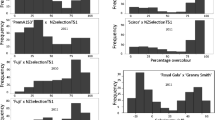Abstract
A simple genetic basis for the red/yellow skincolor polymorphism in apple was verified using DNA markers. Bulked segregant analysis identified one 10-base oligomer that generated different fragments in each of the bulks. After testing the primer in four populations, two fragments were found to be associated with red skin color and another two fragments associated with yellow skin color. Three of the fragments (1160, 1180, and 1230 bp) were partly sequenced and found to share high sequence homology, suggesting these were generated from the same locus. A pair of universal primers were designed to amplify the fragments. In the ‘Rome Beauty’ x ‘White Angel’ population, two fragments were associated with red skin color; one fragment designated as A1 (1160 bp) was from ‘Rome Beauty’ and another fragment (A2, 1180 bp) was from ‘White Angel’. Progeny possessing both fragments, or either one, had red fruit. Both parents displayed an alternate fragment, a1 (1230 bp), associated with yellowskinned fruit. In three other crosses tested, only fragment A1 co-segregated with red skin color; two fragments, a1 and a2 (1230 bp and 1320 bp), were associated with yellow skin color. Our results are consistent with the hypothesis that the red/yellow dimorphism is controlled by a monogenic system with the presence of the red anthocyanin pigmentation being dominant. There was no indication that other modifier genes could reverse the effect of the locus (R f ) linked to the markers. Examination of amplification products in 56 apple cultivars and advanced breeding selections demonstrated that the universal primers could be used to correctly predict fruit skin color in most cases.
Similar content being viewed by others
References
Brown SK (1992) Genetics of apple. Plant Breed Rev 9:333–366
Cheng FS, Roose M L (1995) Origin and inheritance of dwarfing by the citrus rootstock Poncirus trifoliata ‘Flying Dragon’. J Am Soc Hort Sci 120:286–291
Crane MB, Lawrence WJC (1933) Genetical studies in cultivated apples. J Genet 28:265–296
Lancaster JE (1992) Regulation of skin color in apples. Crit Rev Plant Sci 10:487–502
Lespinasse Y, Fouillet A, Flick JD, Lespinasse JM, Delort F (1988) Contribution to genetic studies in apple. Acta Hort 224:99–107
Michelmore RW, Paran I, Kesseli RV (1991) Identification of markers linked to disease resistance genes by bulked segregant analysis: a rapid method to detect markers in specific genomic regions by using segregating populations. Proc Natl Acad Sci USA 88: 9828–9832
Olson M, Hood L, Cantor C, Botstein D (1989) A common language for physical mapping of the human genome. Science 245:1434–1435
Schmidt H (1988) Inheritance of anthocyanin in apple fruit skin. Acta Hort 224: 89–97
Simon CJ, Weeden NF (1991) Elucidation of crabapple lineage by direct examination of rDNA sequences. Malus 5:4–6
Weeden NF, Hemmat M, Lawson DM, Lodhi M, Bell RL, Manganaris AG, Reisch BI, Brown SK, Ye G-N (1994) Development and application of molecular marker linkage maps in woody crops. Euphytica 77:71–75
White AG, Lespinasse Y (1986) The inheritance of fruit colour in apple (Malus pumila Mill.). Agronomie 6:105–110
Williams J, Kubelik AR, Livak DJ, Rafalski JA, Tingey SV (1990) DNA polymorphisms amplified by arbitrary primers are useful as genetic markers. Nucleic Acids Res 18:6531–6535
Author information
Authors and Affiliations
Additional information
Communicated by G. E. Hart
Rights and permissions
About this article
Cite this article
Cheng, F.S., Weeden, N.F. & Brown, S.K. Identification of co-dominant RAPD markers tightly linked to fruit skin color in apple. Theoret. Appl. Genetics 93, 222–227 (1996). https://doi.org/10.1007/BF00225749
Received:
Accepted:
Issue Date:
DOI: https://doi.org/10.1007/BF00225749




